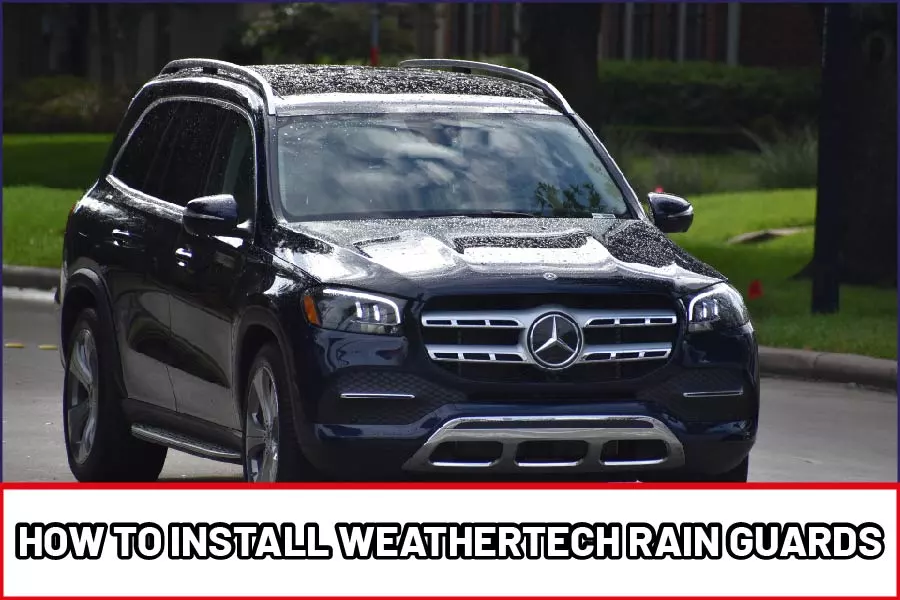Cars ought to be suited for driving in all weather conditions. Over the years, we have seen massive improvements and additions to vehicles to ensure that they are optimized for driving in various climatic conditions.
Perhaps one of the most critical additions in recent times is rain guards. These are plastic arches that curve over the top of your window. They are meant to prevent runoff water from the roof from drenching the inside of your car.
Rain guards are essential, as they allow you to drive with your window open even in wet conditions.
Rain guards are essential, and legally speaking, they are compulsory in many countries. Weathertech is a leading manufacturer of in-car accessories. Their product range is quite broad.
They produce some of the best rain guards in the market.
How To Install Weathertech Rain Guards
Installing the rain guards on the window is a step-by-step process. Do not skip any steps if you want the perfect installation.
Here is how you install rain guards.
Step 1: Cleaning the guard track
It would help if you got rid of all the grime and dirt that might have settled on the window track. The first step is to wrap a small paper cloth around the channel tool.
Run the wrapped channel tool along the paper towel to clean the track. Do this repeatedly until the towel no longer emerges with stains. Do not use too much pressure when cleaning the track.
Step 2: Inserting the deflector flange
You must install the deflector flange on the outer window seal. You must get the correct layer as using the wrong track will obstruct the windows.
Start by tucking the flange ends onto the slot, i.e., the bottom and top flange. You can do it by slightly flexing the rain guard.
Once the ends are in place, slowly work the rest of the rain guard until the rain guard is fully installed.
Step 3: Run the sweep tool:
It would help run the sweep tool to ensure that the window track is free from obstruction.
On installation, raise the windows slowly while applying outward pressure on the flange to ensure that you have installed the rain guard correctly.
For non-curved deflectors;
There are non-curved deflector options, depending on your car design. These deflectors are pretty easy to apply.
Step 1: Clean the window seal
Run the wrapped channel tool along the paper towel to clean the track.
Step 2: Expose the sticky ends:
Remove the strips on either side of the flange to expose the adhesive strips.
Step 3: Installation:
Flex the flange until it fits onto the outer window seal- start midway through the window. Work your way upward by pushing the flange vertically until you get to the top.
Step 4: Run the sweep tool across the channel:
You will ensure that the flange doesn’t obstruct the window track by running the sweep tool across.
Types Of Rain Guards
Deflectors come in different shapes. There are custom guards that come pre-installed from the vehicle’s manufacturer.
Commercially available rain guards are classified according to their installation. There are two types of rain guards: tape-on deflectors and in-channel window visors.
1. Tape-on Deflectors
Tape-on deflectors are custom deflectors that are designed for quick installation. They have an industrial-grade adhesive strip that attaches to the frame of the car’s window.
Tape-on deflectors are easy to apply. They fit perfectly in windows. These rain guards are popular as they provide comparatively more protection than in-channel vent visors.
Tape-on deflectors are fixed away from the window seal. It ensures that there are no obstructions in the window track.
There are shortcomings with these rain guards. They might be easy to install, but they are a nightmare to take off. The adhesive usually is very strong. You will require potent chemicals to dissolve the adhesive when removing the rain guard.
Removing these deflectors might also mean that you would have to repaint the frame where the adhesive lie. The adhesive might also stain your vehicle, making it look terrible.
2. In-channel visors
In-channel visors are the most common types of visors. They are rain guards that slot in the window seal. Installing in-channel rain guards is a bit trickier than just slapping them on with some adhesive.
These rain guards are easy to replace as they pop on and off with ease. The installation process is less messy.
Since they don’t use adhesive, you can perform a cleaner installation. These rain guards have a better aesthetic look than tape on deflectors.
In-channel deflectors are not perfect either. If you install them incorrectly, they are likely to contact the window.
The rain guards are also prone to rattling after some time. It is pretty irritating, and it can lead to uncomfortable journeys.
In-channel visors are also compromised when the rubbery seals get loose. They are likely to fall off.
Factors To Consider When Buying Rain Guards
Rain guards are not easy to purchase. There are so many products, making the selection process a bit difficult.
You are likely to struggle when selecting the perfect rain guard for your vehicle with so many options. This guide will assist you in selecting the best guard:
1. Ease of installation
One of the first things you should consider is the ease of installation. We have seen the two types of rain guards: the tape-on deflectors and the in-channel visors.
These rain guards come with their own set of challenges and disadvantages. You must understand how each one of these rain guards functions.
The most straightforward rain guards to install are the tape-on deflectors. They are, however, difficult to replace.
In-channel visors are challenging to install but are easy to replace. Whichever rain guard you choose, there is a catch.
2. Flex
The rain guard that you select should allow for a bit of flex. Commercial rain guards are not designed to custom fit all vehicles. A bit of flex will enable you to fix the deflector perfectly onto your vehicle.
It will help if you choose rain guards made from acrylic materials as they are flexible. There are also flexible plastic options; however, these are harder to come by. Acrylic rain guards are perfect, especially when installing in-channel visors.
A flexible visor can also easily be used for flat window designs. They are pretty versatile and perfect for all vehicles.
3. Durability
It would help if you chose a rain guard that will last for years. Many rain guards in the market today are flimsy and barely make it past a few months.
Replacing rain guards frequently can be a costly endeavor. It is, therefore, advisable that you select the correct rain guard.
It would help if you selected rain guards from reputable brands. Other things to look out for where durability is a concern are the type of material and the density of the visor.
Always choose acrylic visors. They should be at least 3 mm thick. A decent guard is also flexible enough to bend into the desired shape.
4. The cost of the rain guards
For the most part, decent rain guards will be a bit more expensive than flimsy guards. You must select a decent guard, as they will last longer.
Most guards are pretty affordable. There is no such thing as a premium rain guard, unlike other car parts.
It would help if you avoided cheap rain guards as they usually are poorly made. You will end up spending more money in the long run by constantly replacing them.
Good-quality rain guards are reasonably priced. Ensure you get the best bang for your buck by choosing decent visors.
5. The size of the rain guard
When it comes to choosing rain guards, size matters; the effectiveness and functionality of these accessories depend on their size.
Small rain guards are ideal for small vehicles. In larger vehicles, however, they are practically useless.
You should consider your window dimensions and choose them with the length and thickness of the acrylic strip.
Using excessively large in-channel visors will cause your car’s window seal to unravel. The large rain guards are also likely to fall off due to their weight.
6. Tint
Most rain guards in the market are tinted. The tinted shade should match your car to archive the perfect aesthetic. Plain rain guards are perfect for cars that lack tinted windows.
Tinted rain guards make the car look sleeker. Do not be afraid to experiment with different shades.
Conclusion
Weathertech is a leading manufacturer of car accessories. Their product range is vast, and their catalog is only getting bigger each day.
Weathertech produces industry-leading rain guards for SUVs, trucks, and saloon cars. The installation process for these rain guards is not as straightforward as you might assume.
This piece gives you a step-by-step instructional guide on installing Weathertech rain guards successfully. It also highlights some basic maintenance procedures and provides you with a buying guide.







